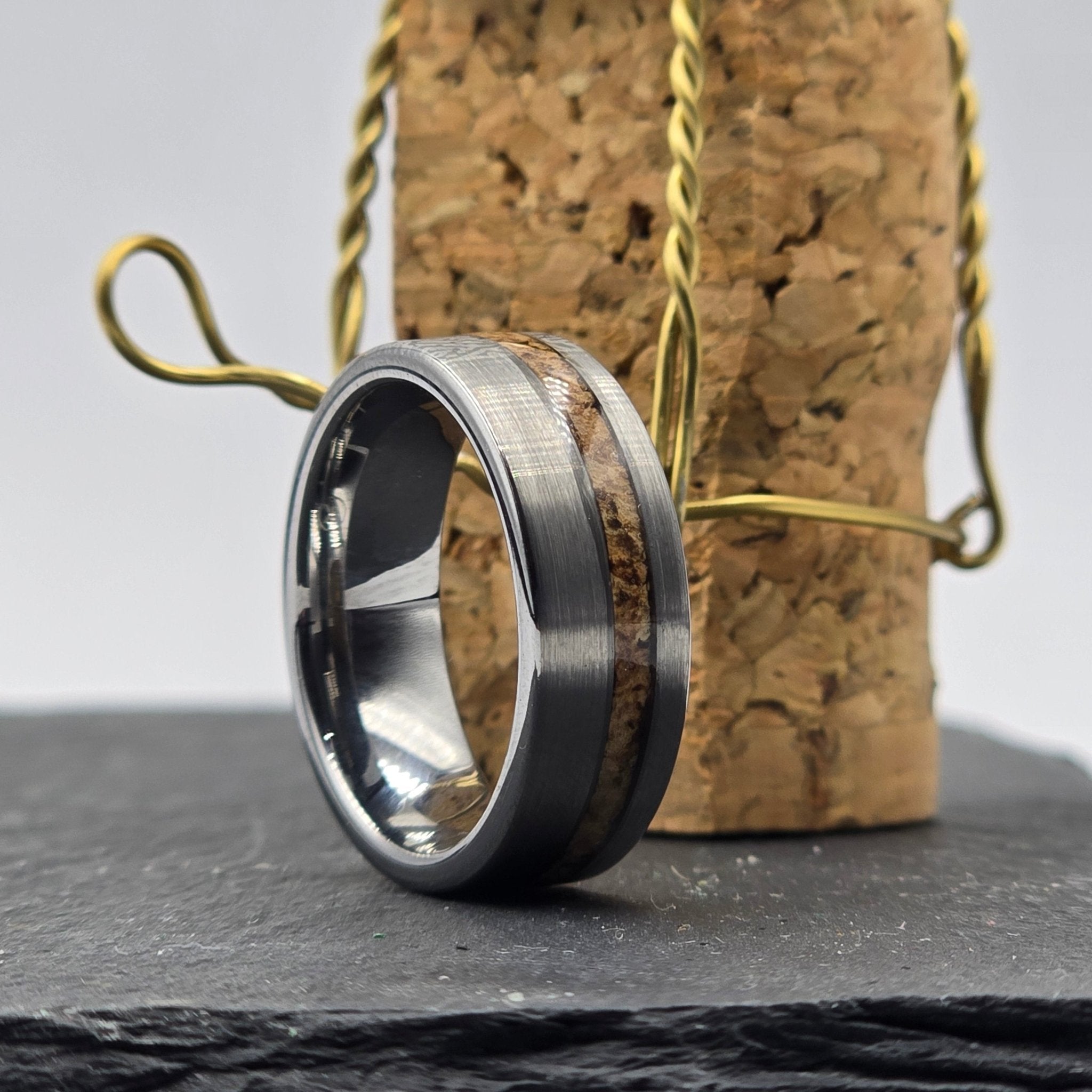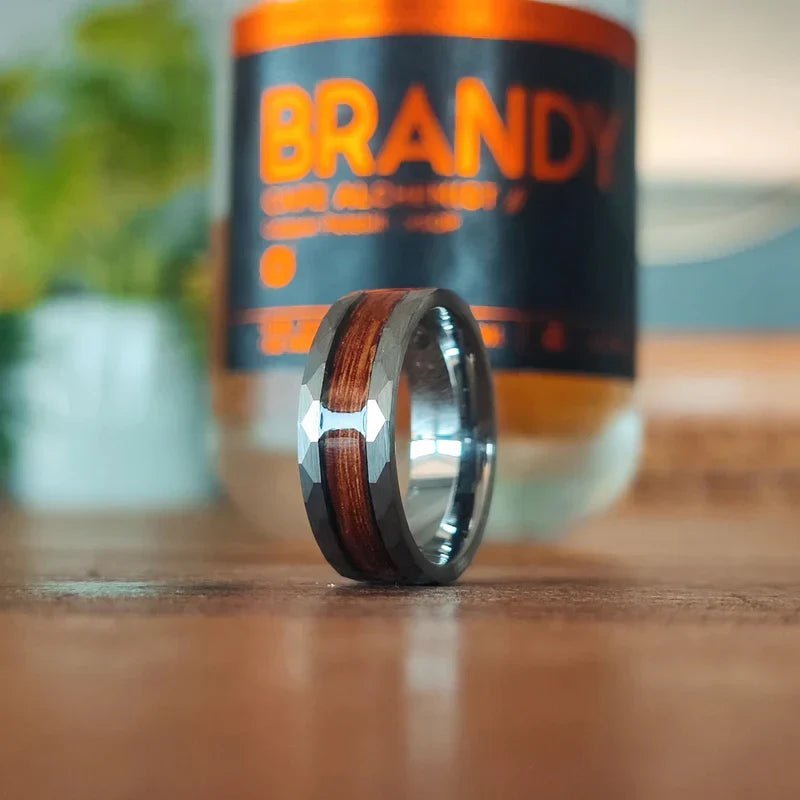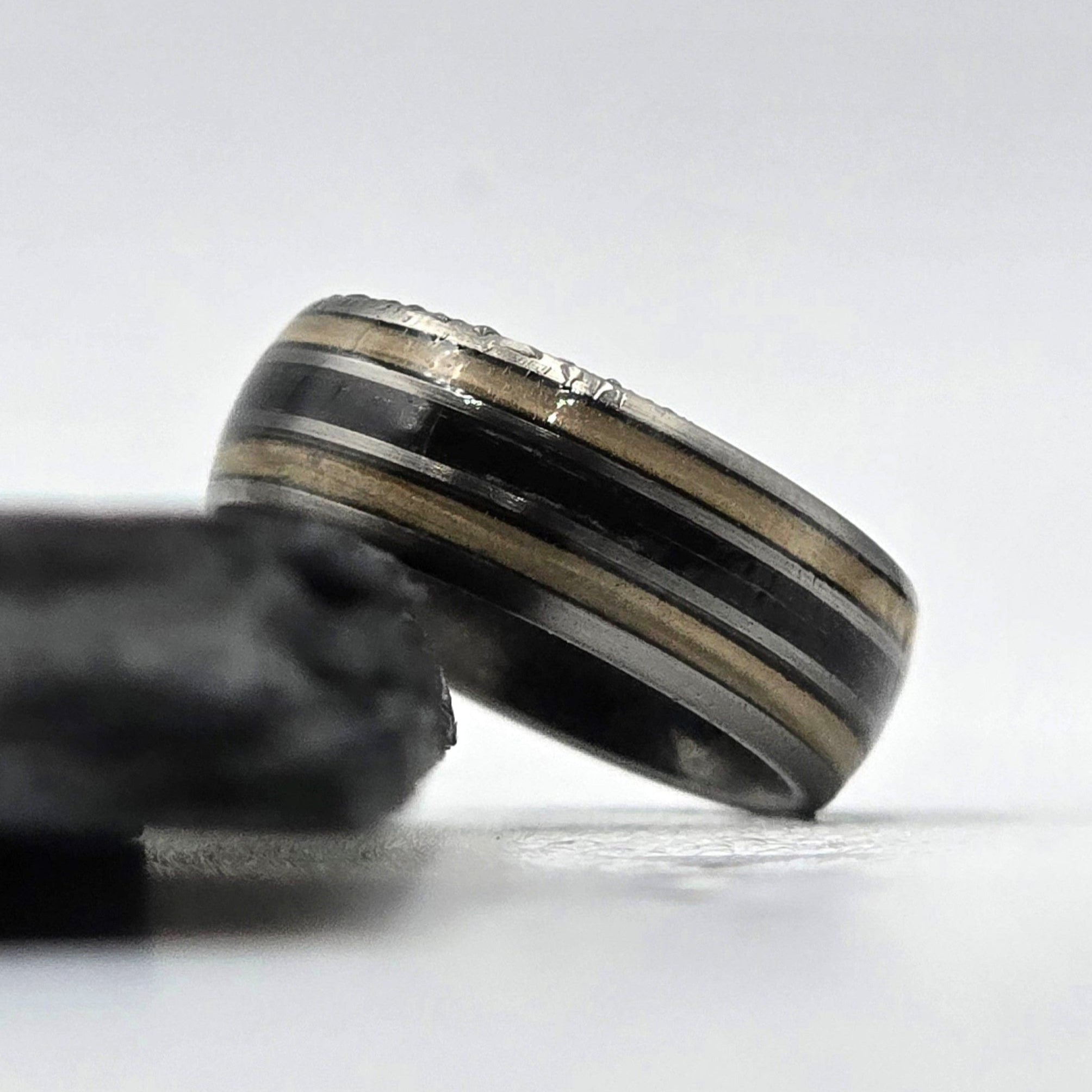
From Celebration to Keepsake: Transforming Your Corkscrew into a Custom Tungsten Ring
Introduction
Every celebration has its tools — the glass that clinks in a toast, the cork that pops with excitement, and the corkscrew that makes it all possible. Whether it’s the bottle you opened at your wedding reception, a graduation party, or just a quiet evening that marked the beginning of something special, the humble corkscrew has been present at some of life’s most memorable milestones. But what happens to that tool once it’s worn, old, or replaced? For most people, it ends up tucked away in a drawer, gathering dust.
Now imagine giving it a new life. Picture that same corkscrew transformed into something bold, modern, and deeply personal: a custom tungsten ring. This is more than jewelry — it’s a story forged into metal, sealed with protective epoxy, and designed to last a lifetime.
In this blog, we’ll explore why keepsakes matter, why tungsten is one of the strongest and most stylish choices for rings, and how artisans transform a trusty corkscrew into a wearable memory. We’ll walk through the process, design choices, maintenance, and real-life examples of these unique rings. By the end, you’ll see why this transformation is the ultimate toast to your journey.
The Appeal of Personal Keepsakes
Keepsakes have always been more than just objects. They are carriers of meaning, symbols of life’s moments, and reminders of experiences we never want to forget. A keepsake doesn’t need to be expensive to be valuable; its worth lies in the memories it holds. For some, it’s a handwritten letter, for others a photograph, and for many, it’s a small object tied to a significant event.
Corkscrews are particularly fascinating in this sense. Unlike a wine bottle, which is consumed, or a cork, which may get lost or thrown away, the corkscrew endures. It’s a companion to countless occasions, standing quietly at the center of celebration after celebration. Over the years, its scratches and wear become part of its story.
Turning such an object into a wearable piece of jewelry elevates it beyond nostalgia. Rather than sitting unseen in a drawer, it becomes a conversation starter, a piece of functional art, and a constant reminder of the celebrations it once opened. Just as people have transformed heirlooms into pendants or rings, transforming your corkscrew into a tungsten ring ensures that its legacy stays with you — not hidden away, but proudly displayed. For those seeking unique designs, exploring custom rings online makes it possible to create something truly personal and meaningful.
Tungsten as a Ring Material: Properties & Advantages
Choosing the right metal is crucial when creating a keepsake that will last. Tungsten carbide has become one of the most popular choices for men’s and women’s rings in recent years, and for good reason.
Tungsten is one of the hardest materials used in jewelry, ranking about 9–9.5 on the Mohs scale of hardness, just below diamonds. This means it is incredibly resistant to scratches, making it ideal for rings that are worn every day. Unlike softer metals such as gold or silver, tungsten maintains its finish for years, resisting the dings and dents of daily life. According to a guide from Jewelry by Johan, tungsten’s durability is one of its greatest advantages, ensuring it holds up even in demanding lifestyles.
Beyond strength, tungsten has a modern, sophisticated look. The brushed gunmetal finish, often used in custom designs, gives it a sleek, understated elegance that pairs perfectly with inlays like corkscrew metal. Its weight adds to the appeal: heavier than titanium or stainless steel, tungsten feels solid and substantial on the hand, which many wearers prefer.
Of course, no material is without its trade-offs. Tungsten is brittle under extreme force, meaning it can shatter rather than bend, and it cannot be resized once made. However, with proper sizing and care, these concerns rarely pose an issue. The payoff is a ring that looks as striking on day 1,000 as it did on day one.
Understanding Inlays: Turning Corkscrew into Jewelry Material
At the heart of transforming a corkscrew into a tungsten ring lies the art of inlay. An inlay is a decorative technique where material is set into a groove or channel within the ring and sealed for protection. Jewelers have used inlays for centuries, incorporating everything from wood and meteorite to opal and bone. The innovation here lies in using a personal corkscrew as the chosen material.
A section of the corkscrew — often from its handle or metallic spiral — is carefully cut, shaped, and fitted into the ring’s channel. Once placed, it is sealed with a clear epoxy resin that both protects the material and enhances its appearance. This step is essential because corkscrews, especially older ones, may carry wear, scratches, or patina. Rather than diminishing their value, these details become part of the charm, preserved under resin for generations.
The process requires precision. A poorly fitted inlay may shift, warp, or lose definition over time. By using a high-quality epoxy, jewelers can ensure the inlay is waterproof, durable, and aesthetically striking. In essence, the inlay transforms the corkscrew from a tool of utility into an eternal centerpiece of design.
Design Considerations & Style Choices
When customizing a tungsten ring, design is just as important as material. The choices you make influence not only how the ring looks but also how it feels.
Width is a critical consideration. An 8mm band, often used in corkscrew inlay designs, offers bold visibility while maintaining balance on the finger. Wider bands allow the inlay to shine, while slimmer bands lean toward subtlety. Fit also matters — most custom corkscrew rings feature a comfort-fit design, where the inner surface is slightly rounded to reduce pressure and make the ring easier to wear.
The dome shape is another common choice, offering a classic silhouette that complements both casual and formal wear. Paired with a brushed gunmetal finish, the result is a modern, masculine aesthetic that highlights the inlay without overwhelming it.
Texture and finish can also transform the final product. A high-gloss epoxy highlights the metallic shine of the corkscrew, while a matte brushed finish gives the tungsten a rugged, industrial appeal. Each choice reflects personal style, ensuring that no two rings are ever exactly alike.
Ultimately, the goal is balance: the ring should be striking enough to tell its story but versatile enough to wear every day.
The Process: From Corkscrew to Custom Ring
Turning your corkscrew into a custom tungsten ring is a process that combines craftsmanship, precision, and artistry.
It begins with you sending in your corkscrew. Jewelers typically consult with clients to identify which part of the tool will be used. Sometimes it’s a handle with sentimental carvings; other times, it’s the metal spiral that physically uncorked the bottles. The chosen piece is cleaned, cut, and shaped into small fragments suitable for inlay.
Meanwhile, a tungsten ring blank is prepared. Jewelers mill a channel into the ring, ensuring the width and depth are suitable for the inlay material. Once ready, the corkscrew fragment is carefully fitted into place. This is where craftsmanship shines: the artisan must ensure that the material sits flush, with no gaps or uneven edges.
Next comes the epoxy resin. The jeweler mixes and pours it over the inlay, filling the channel and creating a smooth, protective layer. The resin is cured, then sanded and polished to perfection. Finally, the brushed finish is applied to the tungsten, highlighting its sleek gunmetal look while preserving the corkscrew’s unique details beneath the epoxy.
The entire process can take several days to weeks, depending on curing times and workload. What emerges is a ring that’s one-of-a-kind — as personal as it is durable.
Why Epoxy/Resin Matters: Protection & Longevity
Epoxy resin may be invisible in the finished product, but it plays a vital role in the ring’s longevity. Without it, the inlay would be exposed to water, dirt, and wear, quickly losing its beauty and structure.
Resin works by encapsulating the inlay, forming a waterproof, protective barrier. High-quality resins are crystal clear, allowing the details of the corkscrew to shine through while shielding them from scratches or chemical damage. Two-part epoxy is most commonly used, though UV-cured resins are also gaining popularity for their speed and clarity.
Over time, poor-quality resin can yellow or crack, which is why professional jewelers rely on resins designed for long-term stability. Customers can also prolong resin clarity by avoiding prolonged exposure to direct sunlight or extreme heat.
The resin doesn’t just preserve the inlay — it enhances it. By magnifying the details beneath, it brings out textures, engravings, and patina that might otherwise go unnoticed. In this way, epoxy isn’t just protection; it’s part of the artistry.
Fit, Sizing, and Comfort Fit Concerns
One of the most critical steps in ordering a tungsten ring is getting the size right. Unlike gold or silver, tungsten cannot be resized once it has been made. This is due to its hardness; attempting to alter it risks cracking the entire band.
That’s why jewelers strongly recommend measuring carefully, often more than once. Using a professional sizing tool or visiting a local jeweler for measurement is the best option. Some artisans even provide sizers for clients to test before finalizing their order.
Comfort fit design is another essential consideration. In comfort fit rings, the inside surface is slightly rounded rather than flat. This makes wider bands, such as 8mm rings, easier to wear for long periods, as they reduce pressure on the finger.
The dome shape also adds comfort by preventing the edges from digging into the skin. While tungsten is heavier than many metals, most wearers come to appreciate its solid feel. If weight is a concern, it’s important to try on a tungsten band in advance to ensure it feels right.
In short, correct sizing paired with comfort fit design ensures that your corkscrew keepsake ring doesn’t just look meaningful — it feels great to wear every day.
What to Expect When Ordering (Timeline, Cost, Custom Trade-offs)
Ordering a custom corkscrew tungsten ring is not the same as buying an off-the-shelf piece of jewelry. The process requires time, communication, and realistic expectations.
Timelines vary depending on the jeweler, but most custom projects take longer than standard production. As noted in product guidelines, custom corkscrew rings may take an additional 3–9 working days beyond normal lead times. Factors include receiving your corkscrew, preparing it, and allowing epoxy resin to cure fully.
Costs also vary. Beyond the price of the tungsten base, there are labor charges for cutting, shaping, inlaying, and finishing. Shipping your corkscrew to the jeweler may add a small expense, but the result is a one-of-a-kind heirloom.
Because each ring is made with your material, exchanges are limited. Many jewelers, including The Corkey, offer exchanges at 50% of the selling price. This reflects the fact that the original material cannot be reused once crafted.
Customers should also expect slight variations in the final appearance. Resin clarity, corkscrew texture, and brushed finishes all contribute to individuality. Rather than being flaws, these are part of the ring’s unique story — no two are ever the same.
Care & Long-Term Maintenance
A custom corkscrew tungsten ring is built to last, but like any piece of jewelry, it requires care. Fortunately, maintenance is straightforward.
For cleaning, mild soap and warm water are sufficient. Use a soft cloth to wipe the surface and avoid harsh chemicals such as chlorine, bleach, or strong detergents, which can damage both resin and metal.
Protecting the brushed finish is also important. Tungsten resists scratches exceptionally well, but the resin layer can be marred if struck against hard surfaces. Removing the ring during heavy labor, sports, or abrasive tasks is a good practice.
Storage matters too. Keeping the ring in a padded jewelry box, away from humidity and direct sunlight, helps preserve both the epoxy and the metal finish. Over years of wear, some resin may develop minor clouding or scratches. If this happens, jewelers can often repolish or reapply epoxy to restore clarity.
By following these simple steps, your ring will remain as striking as the day it was crafted, ensuring your corkscrew’s legacy lives on in perfect condition.
Real Stories & Examples
The beauty of custom corkscrew rings lies in their individuality. Each one carries not just the story of the material, but also the story of the person who wears it.
One customer shared how their corkscrew had been with them through countless wine nights with friends and was even used during their engagement dinner. When that corkscrew was finally retired, turning it into a ring meant those memories were never far away. The brushed tungsten band contrasted beautifully with the worn spiral of the corkscrew, now protected under glossy epoxy.
Another example involved a corkscrew gifted by a late family member. Transforming it into a ring created an heirloom that honored both the person and the moments shared. The result was more than a piece of jewelry — it was a daily reminder of love and connection.
Wearers often remark on how much attention these rings draw. Friends and strangers alike are curious about the unusual inlay, sparking conversations that allow wearers to share their story. Beyond aesthetics, the durability of tungsten ensures the ring withstands everyday life while holding onto those memories.
In every case, the transformation turns an ordinary tool into an extraordinary symbol of personal history.
Conclusion
Keepsakes remind us of the stories we hold dear, and few transformations are as creative and meaningful as turning a corkscrew into a tungsten ring. By combining the strength and style of tungsten with the personal history of your corkscrew, you get more than jewelry — you get a wearable story.
From understanding the durability of tungsten and the artistry of inlays to appreciating the role of epoxy and the importance of sizing, every detail of the process is designed to create a ring that is as unique as you are. While custom orders may take more time and care, the result is worth it: a bold, durable, and deeply personal keepsake you’ll treasure for years.
So, the next time you look at that old corkscrew, remember it doesn’t have to stay tucked away. With the right craftsmanship, it can live on as a timeless ring — a toast to your memories, your journey, and the celebrations yet to come. Cheers to that.



